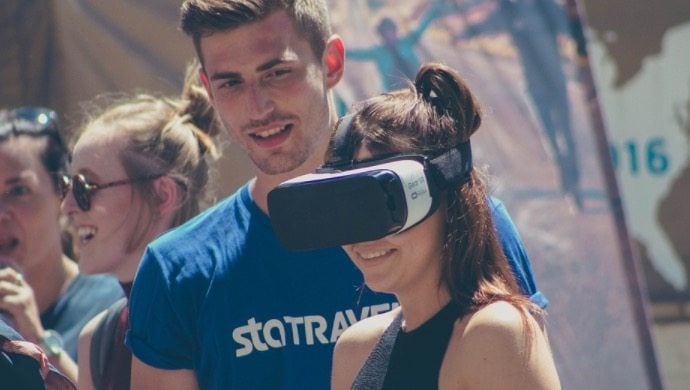Are AR and VR just a fad, or are these immersive technologies here to stay?

Both augmented reality (AR) and virtual reality (VR) have been around for quite a while now, yet we haven’t seen any major success in either of these spaces yet. Analysts have ambitiously predicted that the market will be worth US$120 to 150 billion by 2020, but what really makes them think so?
We’re all curious to know when this industry will take off, and having looked at this for a couple of months now, I’d like to share some thoughts.
Right from the 1950s, there have been multiple attempts at both AR and VR, with some of the more well-known efforts being Morton Heilig’s ‘Sensorama’ and Nintendo’s ‘Virtual Boy’. Unfortunately, earlier iterations were not widely adopted due to technical and design limitations, steep price points, and failure to deliver value to users.
What’s different now?
With the explosion of the mobile and gaming industries between 2007 and 2012, a significant amount of money and effort was channeled towards developing the technology to support these industries. As a result, we now see huge advancements in areas such as GPUs, computer vision, sensors, graphics, and optics. These industries have driven down prices of technical components that are now enabling the AR/VR industry. Knowledge spaces have also expanded with more efficient algorithms and rendering techniques.
Consumers are also adopting new technologies much faster now, evident with the recent craze over Pokémon Go — an AR game that managed to capture over 20 million active users in just over two weeks. With this rise in awareness of AR, adoption may be driven further.
Also Read: Is this the beginning of the end for Pokémon Go?
AR/VR is also no longer perceived as just gaming or entertainment technology. In fact, there are many more serious applications in areas such as healthcare, education, and retail. Tech giants seem to see the potential, evident by Facebook’s acquisition of Oculus in 2014 and many other big players following suit and entering the industry.
Funding has also increased, with 2016 seeing a significant rise in venture deals and the formation of many new AR/VR dedicated funds and incubators. These are just some of the factors that have been and will continue fuelling the growth of the industry.
Areas of innovation
Despite uncertainties in the industry, some startups are determined to find success. Out of the 32 I came across, three in particular caught my eye as they were innovative, unique, and had a strong value proposition.
The first company is Lytro, an end-to-end solution that utilises light field technology to produce professional VR content. This was interesting because the unique technology may be a game-changer for content creators, allowing computer-generated imagery to be easily merged with captured content.
Also Read: Curious about augmented reality? Here’s how your business can benefit
The second company is Fove, an eye-tracking headset that knows exactly where the user is looking with imperceptible delay. I found this interesting as it enables a technique known as ‘foveated rendering’, thereby saving graphics rendering power and allowing a more immersive experience that is natural to the human eye.
The third company is Blippar, a visual search engine for the real world. We have yet to see success in anyone creating a horizontal search engine that can deliver content about anything in real-time through a simple visual search, but Blippar is hoping to do it.
These startups are challenging the industry with their highly relevant verticals, and are hoping to prove that this is the right time for AR/VR.
AR vs VR
The AR market will probably be much bigger than the VR market, solely due to the fact that it can disrupt the smartphone and tablet industry. With high smartphone penetration worldwide, and the increased need for users to multi-task, AR provides a more relevant experience as it is not limited to a physically closed space like VR, and can instead be used on-the-go, and at any time.
Having said that, VR technology would still be relevant in many other verticals, and is currently more advanced than most AR technology.
Right time, or no?
Despite all the technological advancements and changes in consumer behaviour, I believe the AR/VR market still needs about three to five years before the timing is right. Prices are still too high, and technology has to be improved such that the user experience is smooth and seamless.
Headsets are still a bit bulky, but they will eventually get smaller, lighter and more portable — AR glasses might be reduced to smart contact lenses, and VR headsets might look more like regular glasses.
Upcoming 5G network capabilities will also fuel the industry, and in a few years I believe AR/VR will take off and flourish. As for now, startups can still find success if they own a vertical or find an intersection between their existing business and AR/VR.
P.S. – Shoutout to the team at Singtel Innov8 for their guidance and mentorship over the summer!
—-
The views expressed here are of the author’s, and e27 may not necessarily subscribe to them. e27 invites members from Asia’s tech industry and startup community to share their honest opinions and expert knowledge with our readers. If you are interested in sharing your point of view, submit your post here.
Image Credit: Pixabay
The post Is this finally the right time for the AR/VR industry to shine? appeared first on e27.